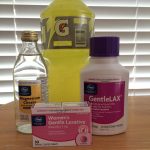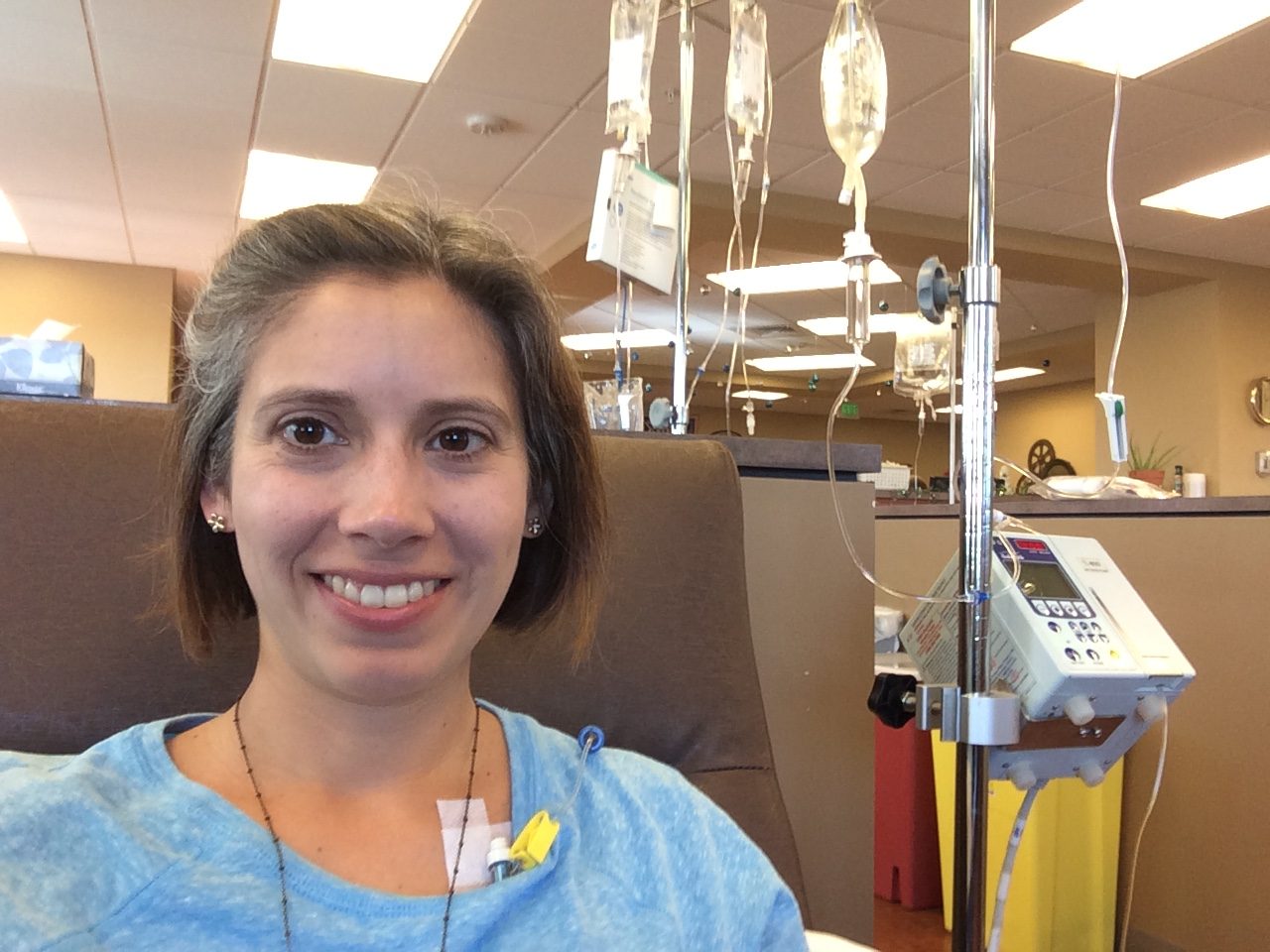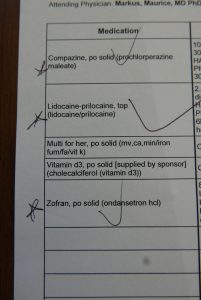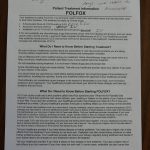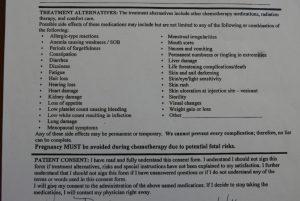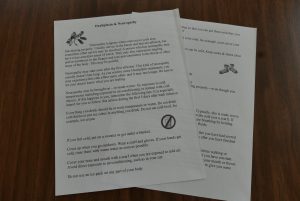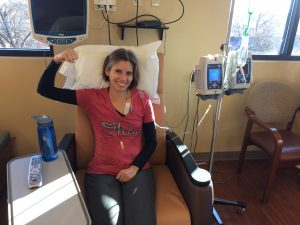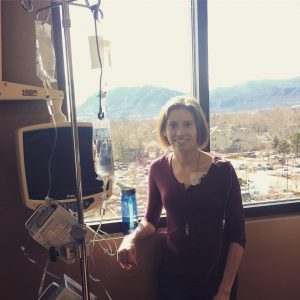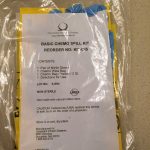
More Details on Going Through FOLFOX Chemo
Welcome to Life as a Cancer Survivor. In today’s video, I’m going to talk all about what it’s like to go through IV chemotherapy. My name is Jelena and I went through eight rounds of FOLFOX chemotherapy to treat my Stage Three Rectal Cancer diagnosis. I was diagnosed with Rectal Cancer in May of 2016 and began the first of my eight rounds of IV chemotherapy in December of 2016. Click the like button down here below if you’re ready to hear about what it’s like to go through multiple rounds of chemotherapy.
A few videos ago I talked about the side effects that you could possibly experience while on chemo and the ones that I experienced. So in this video, I’m going to talk more about just the day-to-day happenings of what it really is like to go through chemotherapy. Let me start out with being at the cancer center for your infusion. Usually, there’s a special infusion room and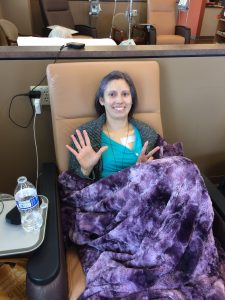 there’s a nurse’s station in the middle of this large infusion room. At mine they kind of had it divided up into little “rooms” where there were half walls and within each of those rooms, there were about four to five chairs that you could sit at. Each of those chairs reclined, some of them had TVs at them, and others had an extra chair next to them so that a visitor could sit next to you during your infusion. I always got a pillow and put it behind my back but I would bring with me my own super cozy and soft blanket that my husband, John, had bought me. I would bring with me a pair of cozy slipper socks and I would take my shoes off and just put those slipper socks on since I was there at the infusion for three hours. I would also bring water, either snacks or a lunch depending on what time my infusion was, my phone of course, and then a tablet and headphones. John came with me for many of my infusions but he would bring his work laptop with him and many times he had meetings that he had to attend so I couldn’t rely on him as my sole source of entertainment. So on my tablet, I downloaded games, I downloaded some tv-shows and used those to keep me occupied and that’s where the headphones came in handy for listening to the tv shows. I also let my mom, sister, aunt, and one of my cousins know what time my infusions were and they would keep me occupied in a group text with just funny texts or gossip. Personally, I could never fall asleep during the infusions.
there’s a nurse’s station in the middle of this large infusion room. At mine they kind of had it divided up into little “rooms” where there were half walls and within each of those rooms, there were about four to five chairs that you could sit at. Each of those chairs reclined, some of them had TVs at them, and others had an extra chair next to them so that a visitor could sit next to you during your infusion. I always got a pillow and put it behind my back but I would bring with me my own super cozy and soft blanket that my husband, John, had bought me. I would bring with me a pair of cozy slipper socks and I would take my shoes off and just put those slipper socks on since I was there at the infusion for three hours. I would also bring water, either snacks or a lunch depending on what time my infusion was, my phone of course, and then a tablet and headphones. John came with me for many of my infusions but he would bring his work laptop with him and many times he had meetings that he had to attend so I couldn’t rely on him as my sole source of entertainment. So on my tablet, I downloaded games, I downloaded some tv-shows and used those to keep me occupied and that’s where the headphones came in handy for listening to the tv shows. I also let my mom, sister, aunt, and one of my cousins know what time my infusions were and they would keep me occupied in a group text with just funny texts or gossip. Personally, I could never fall asleep during the infusions.
I mentioned that you’re there for about three hours for, you know, for your infusion. I had a port implanted which is a device that goes into your chest and it has a small tube that comes out of it that goes into one of your large veins. Once you’re hooked up to the IV and  the chemo pumps through a needle that’s inserted into your port you’re not stuck in that chair the entire time. The nurses showed me how to unplug the chemo pump because it had a battery in it as well so it could run for a little while without being plugged in. So they showed me how to unplug it and take the pole with me to the bathroom because I had to go multiple times during the infusion. At my cancer center, they had three to four individual bathrooms that were large, accessible-sized bathrooms so even with you and that chemo pole you didn’t feel cramped inside the bathroom at all and had tons of room to maneuver around in there.
the chemo pumps through a needle that’s inserted into your port you’re not stuck in that chair the entire time. The nurses showed me how to unplug the chemo pump because it had a battery in it as well so it could run for a little while without being plugged in. So they showed me how to unplug it and take the pole with me to the bathroom because I had to go multiple times during the infusion. At my cancer center, they had three to four individual bathrooms that were large, accessible-sized bathrooms so even with you and that chemo pole you didn’t feel cramped inside the bathroom at all and had tons of room to maneuver around in there.
Once I was finished with the in-person chemotherapy, I got disconnected from that and connected to a chemo pump that would dispense chemo to me for the next 46 hours. They gave me a fanny pack and an over-the-shoulder bag that I could choose from to put that pump into for carrying it around for the next two days. I chose the over-the-shoulder bag because it was more comfortable and the fanny pack was actually too big on me even when I pulled it as small as it could get it was still too large. So then once I got home I would always immediately go to bed and take a nap for at least two hours. You’ve been through a lot physically and mentally at chemo, so most people that I know go and take a nap as soon as they get home. The headboard of my bed has a post on the end of it so I would hang the bag on that and tuck the hose into the bag as much as I could so that I didn’t have to worry about getting tangled up in it and I didn’t have to worry about my cats chewing on that hose. The hose was about three feet or so long so there’s a lot that you can work with to figure out where exactly you want to put the pump when you’re sleeping to be the most comfortable.
So for the next two days, that pump went everywhere with me. I felt pretty cruddy but I  tried to not use that as an excuse to not do anything. The bag fits nicely into the water bottle holders on a treadmill so for my first rounds of chemo I would just put the pump in there and I would go to the gym and I would run. As I got further along in treatment I was too tired to run so I would only walk, and I would either walk outside or on the treadmill at the gym. I would only walk outside if it was at least 50 degrees because I was going through chemo in the winter in Colorado and Oxaliplatin, one of the drugs that’s in FOLFOX, it causes extreme cold sensitivity and if I would go outside and it was colder than about 50 or if the wind was blowing strongly it felt like needles were stabbing me in the face constantly. So I wouldn’t subject myself to that I would just go to the gym and walk if it was cold or windy.
tried to not use that as an excuse to not do anything. The bag fits nicely into the water bottle holders on a treadmill so for my first rounds of chemo I would just put the pump in there and I would go to the gym and I would run. As I got further along in treatment I was too tired to run so I would only walk, and I would either walk outside or on the treadmill at the gym. I would only walk outside if it was at least 50 degrees because I was going through chemo in the winter in Colorado and Oxaliplatin, one of the drugs that’s in FOLFOX, it causes extreme cold sensitivity and if I would go outside and it was colder than about 50 or if the wind was blowing strongly it felt like needles were stabbing me in the face constantly. So I wouldn’t subject myself to that I would just go to the gym and walk if it was cold or windy.
I asked the nurses at the cancer center if it was okay if I showered while I had the chemo pump attached to me and they told me that it was fine as long as I didn’t get the pump wet. They said that the dressing that was over the needle was waterproof so it was supposed to keep any water and sweat out and away from where the needle was. So to shower I would get a hanger, I used a metal hanger because it’s bendy and so I could bend it to whatever angle I needed it, so I would hang the over-the-shoulder bag on the hanger, and then place the hanger on the outside of my shower so the pump was on the outside and since you’ve got a long hose I would just untuck the hose most of the way and I showered with the chemo pump on. I wouldn’t scrub super hard around where the, um, the dressing was I would just soap up and then just let the soap flow over it but I never got it wet, never had any problems uh with any water getting in and doing anything to my port.
For sleeping at night I was worried about two things. One, that I was gonna get tangled up in the hose, and two that I was gonna forget that I had the pump attached to me and would get up and start walking away and get yanked by the pump still hanging on my headboard. As I mentioned earlier, I would hang my over-the-shoulder bag on the post of my headboard and then tuck the hose in as much as I could, that seemed to work and I never got tangled up in the hose when I was sleeping. As far as waking up and forgetting that I had the pump attached to me, whenever I’d wake up in the middle of the night and need to go to the bathroom I always wake up and I just lay there for a minute or two because I’m like, “Oh do I really have to get up or can I fall back asleep?” Of course, I could never fall back asleep but while I’m laying there and debating how long I’m gonna wait before I get out of bed, you would hear the pump disperse the chemo once or twice so that would be my reminder, “Oh yeah I’ve got that bag over here I need to grab that and take that with me before I go to the bathroom.” And in case you’re wondering what that pump sounds like each time that it dispenses the chemo, to me it sounds most like one of those automatic hand sanitizer dispensers put your hand under and it just dispenses um only it’s a little bit quieter than one of those.
On the days that my pump wasn’t attached, I would occasionally try lifting weights while I was at the gym. There were many movements that I didn’t do because they were too painful from the port location. First off I couldn’t lift my arm more than shoulder height without it being very painful on my at my port so that meant no jumping jacks or tricep stretches like where you do this it hurt to bring my arm up that high. It was also painful to do chest presses or stretches where you would take your arm across your body. Since I wasn’t hardcore into weightlifting I just did other exercises or avoided those stretches that hurt the port site.
I went into the cancer center on Tuesdays for my infusion, every other Tuesday to be exact, um then I would go back on Thursday right before they closed to get the pump detached from me. I would usually feel pretty crappy until Saturday or Sunday. Once the weekend hit the cold sensitivity started easing up so I wouldn’t have to warm up all of my beverages, the tingling in my feet would ease up, and I stopped my anti-nausea medications so the nausea was gone and I wasn’t as sleepy. The following week I would really start bouncing back. My energy increased and that just general crappy feeling started easing up. Then over the next weekend, I felt almost back to normal just in time for the infusion to get started again and that cycle to start on Tuesday.
My cancer center gave out vouchers, if you asked them, that were good for a season ski  pass at Loveland Ski Area for only $89. Once you went to Loveland and got that pass you could also use it at multiple partner resorts to get a limited number of free lift tickets at those places as well. So the weekend right before my Tuesday infusion we went skiing multiple times. I would get colder than I usually would so I would have to bundle up with extra layers and covered up everything so there was pretty much no skin showing. I also invested in some of the hand/foot warmers and would put those in my boots and in my gloves to keep me warm, and even to this day if we’re doing anything outdoorsy in the cold I’d take those foot and hand warmers with me.
pass at Loveland Ski Area for only $89. Once you went to Loveland and got that pass you could also use it at multiple partner resorts to get a limited number of free lift tickets at those places as well. So the weekend right before my Tuesday infusion we went skiing multiple times. I would get colder than I usually would so I would have to bundle up with extra layers and covered up everything so there was pretty much no skin showing. I also invested in some of the hand/foot warmers and would put those in my boots and in my gloves to keep me warm, and even to this day if we’re doing anything outdoorsy in the cold I’d take those foot and hand warmers with me.
I did eight rounds of FOLFOX, so as I got further and further along in treatment the fatigue really started setting in and those afternoon naps started becoming almost a daily thing. My appetite went down but I was still eating okay when I went in for that last round of chemo. My hair, it definitely thinned out even my eyebrows and my eyelashes did but I started out with pretty thick hair, so to anybody that wasn’t my family it wasn’t really super noticeable. It was tough, but I knew that going through these eight rounds of FOLFOX would give me the best chance at living a long, cancer-free life so I just kept that finish line in sight. I just had to get through this and then treatment would be done.
Please click on the like button down here if this video gave you a better idea of what it’s like to go through chemotherapy. Also make sure that you’ve hit the subscribe button and clicked on the bell so you’ll be notified when all my future videos are posted. I know you don’t want to miss any of them. Thank you guys so much for watching!
*This video was originally published on July 31, 2020.




